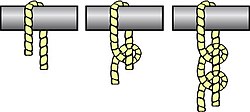m (+trans) |
(Marked this version for translation) |
||
| Line 1: | Line 1: | ||
{{Knot | {{Knot | ||
| − | | name = <noinclude><translate></noinclude>Two half hitches<noinclude></translate></noinclude> | + | | name = <noinclude><translate><!--T:1--> |
| + | </noinclude>Two half hitches<noinclude></translate></noinclude> | ||
| image = Knot 2 half hitches.jpg | | image = Knot 2 half hitches.jpg | ||
| use = | | use = | ||
| − | <noinclude><translate></noinclude> | + | <noinclude><translate><!--T:2--> |
| + | </noinclude> | ||
This reliable knot is quickly tied and is the hitch most often used in mooring. | This reliable knot is quickly tied and is the hitch most often used in mooring. | ||
<noinclude></translate></noinclude> | <noinclude></translate></noinclude> | ||
| tying_instructions = | | tying_instructions = | ||
| − | <noinclude><translate></noinclude> | + | <noinclude><translate><!--T:3--> |
| + | </noinclude> | ||
#Pass end of rope around post or other object. | #Pass end of rope around post or other object. | ||
#Wrap short end of rope under and over long part of rope, pushing the end down through the loop. This is a half hitch. | #Wrap short end of rope under and over long part of rope, pushing the end down through the loop. This is a half hitch. | ||
Revision as of 03:16, 31 October 2014
| Two half hitches |
|---|
|
Use: This reliable knot is quickly tied and is the hitch most often used in mooring.
How to tie:
|

